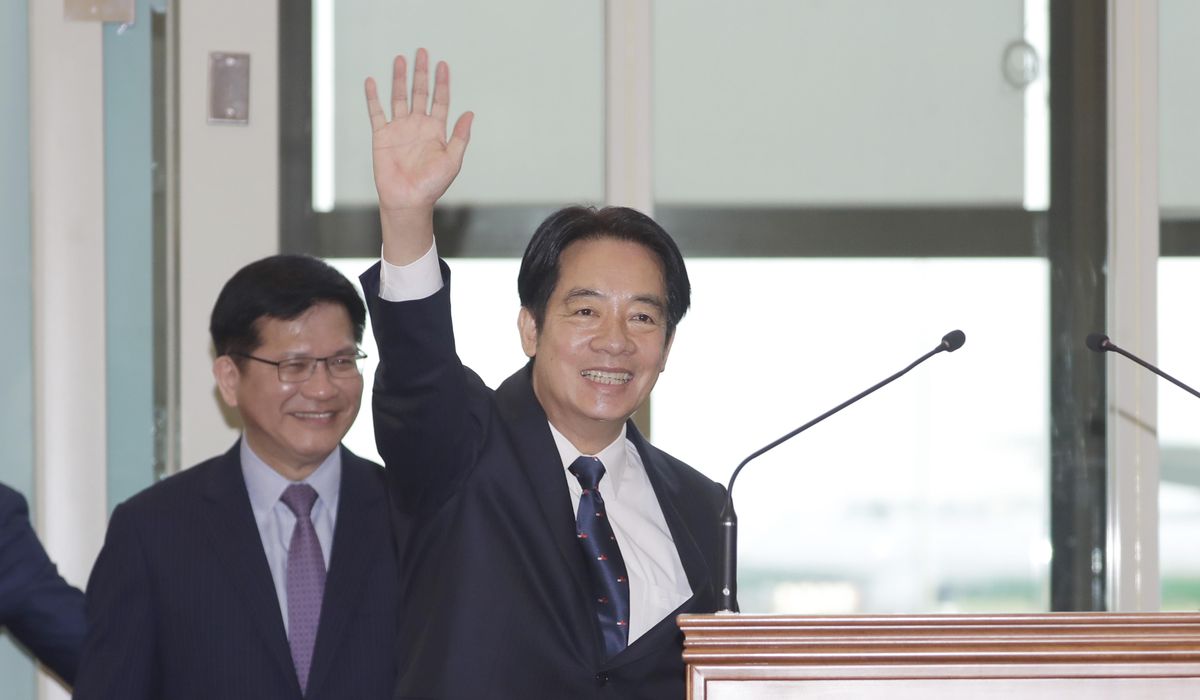SEOUL, South Korea – A potentially game-changing link-up between two Taiwanese opposition parties to challenge the ruling Democratic Progressive Party has foundered – for now.
Voters on the democratic island, which lies in the shadow of China and is also a critical hub in the global high-tech supply chain, go to the polls on January 13 to vote for their next president. Sitting President Tsai In-wen of the DPP, now finalizing her second term, is constitutionally unable to run for a third.
The DPP’s presidential candidate Lai Ching-te, also known as William Lai, leads recent polls with around 32%. He is seen as a hard-liner toward China.
The two opposition parties seeking to win the presidency are regarded as more accommodating toward Beijing. Mr. Lai’s main opponents are each polling at around 22%, suggesting a Lai victory unless they join forces.
An initiative was announced Wednesday under which Hou Yu-ih of the main opposition Kuomintang (KMT), and Ko Wen-je of the Taiwan People’s Party (TPP) agreed on a joint campaign.
According to Taipei media Taiwan News, the two opposition leaders were unable to agree Saturday on polling methodologies to select which one would be the presidential candidate.
Hopefuls must register their candidacies by November 24 at the latest, giving Mr. Ko and Mr. Hou six days to find a compromise.
U.S. united on Taiwan, Taiwanese divided
With Washington deeply concerned about possible Chinese attempts to take over the democratic island, Taiwan is a lynchpin of U.S. Indo-Pacific strategy.
On the security front, ongoing moves by U.S. forces and their allies to establish defenses in both the northern Philippines and in Japan’s southern islands are aimed at preventing China’s navy from blockading or surrounding Taiwan.
On the economic security front, Taiwan is a critical hub in the supply chain for cutting-edge semiconductors. Washington has identified chips as the key component to maintain the high ground over China in high-tech competition.
In Washington, a strong posture against China is one of the few political terrain shared by Democrats and Republicans.
Taiwanese, however, are divided.
“Lai’s support comes primarily from the more radical wing of the DPP, which favors a more insistent approach to Taiwan’s self-determination and national sovereignty,” according to the Asia Society Policy Institute. The KMT’s Hou has called Lai “reckless” for his posture.
The TPP’s Mr. Ko is seen as more middle of the road but has proposed building a bridge between one of Taiwan’s outlying islands to the (nearby) Chinese mainland.
Voters focus on a smorgasbord of domestic issues: stagnant wage growth, a sluggish economy, energy security and even affordable housing for the younger generation.
In these areas, the two-term government is assessed to have failed. Mr. Koh is especially popular with youth, who consider the DPP to be the establishment and who are unattracted to the ever-older-school KMT.
However, Washington and the wider world are watching the election due to relations across the flashpoint Taiwan Strait. Chinese strategy toward Taiwan is hotly debated.
Multiple U.S. security figures, citing the build-up of Chinese forces, most notably naval, believe China is amassing the capabilities and the will to attack the island.
They point to aggressive maneuvers by Chinese naval and air assets around Taiwan, which have increased massively since U.S. House Speaker Nancy Pelosi visited the island in 2022, infuriating Beijing.
But others suggest that Beijing, which has not fought a hot war since 1979, has a regional “salami-slicing” strategy in the region, from the Himalayas to the South and East China Seas. That strategy focuses on minimalist, gradual gains – more hybrid war than hot war.
At sea, it deploys under-gunned vessels such as the Coast Guard and “maritime militias,” rather than its battle fleet, into tense waters. In the air, it probes and pilots aggressively but does not shoot.
Western arms executives have told The Washington Times of their frustration with Taipei, which they say is unwilling to do what is necessary to defend itself.
They also cite the country’s short conscription – just one year – and its refusal to stand up a militia. Militias were critical in the defense of northern Ukraine in 2022.
“Any complacency or nonchalance on the part of the Taiwanese is maybe because they are reassured,” said Alexander Neill, a regional defense expert with the Pacific Forum.
“Underpinning this is the Taiwan Relations Act: The U.S. is mandated to provide sufficient capability to defend Taiwan.”
Clearing up any strategic ambiguity in that act, President Joe Biden has stated clearly that the U.S. would defend Taiwan. Yet, Washington has customarily been reluctant to see Taiwan acquire top-of-range assets.
“The DPP were constantly lobbying for new F16 variants, and they complain about getting US cast-offs,” Mr. Neill said. “But as soon as Taiwan starts developing something that looks like a good offensive capability, the US gets un-nerved.”
For Taiwanese, it’s a dilemma.
“Some say we should not become a chess piece in the hands of America, but in reality we need support as we are not powerful, like Israel,” said one Taiwanese, who spoke on condition of anonymity as he did not have permission to speak to media. “Because of the U.S. trade war with China, we have to choose a side.”
China’s harsh crackdown on Hong Kong in 2019 shocked Taiwanese. However, memories are short and youth do not necessarily share the older generation’s distrust of Beijing.
“The Hong Kong situation changed the game, it made us feel more at risk,” said the source. “But this mindset is now evaporating.”
𝗖𝗿𝗲𝗱𝗶𝘁𝘀, 𝗖𝗼𝗽𝘆𝗿𝗶𝗴𝗵𝘁 & 𝗖𝗼𝘂𝗿𝘁𝗲𝘀𝘆: www.washingtontimes.com
𝗙𝗼𝗿 𝗮𝗻𝘆 𝗰𝗼𝗺𝗽𝗹𝗮𝗶𝗻𝘁𝘀 𝗿𝗲𝗴𝗮𝗿𝗱𝗶𝗻𝗴 𝗗𝗠𝗖𝗔,
𝗣𝗹𝗲𝗮𝘀𝗲 𝘀𝗲𝗻𝗱 𝘂𝘀 𝗮𝗻 𝗲𝗺𝗮𝗶𝗹 𝗮𝘁 dmca@enspirers.com



